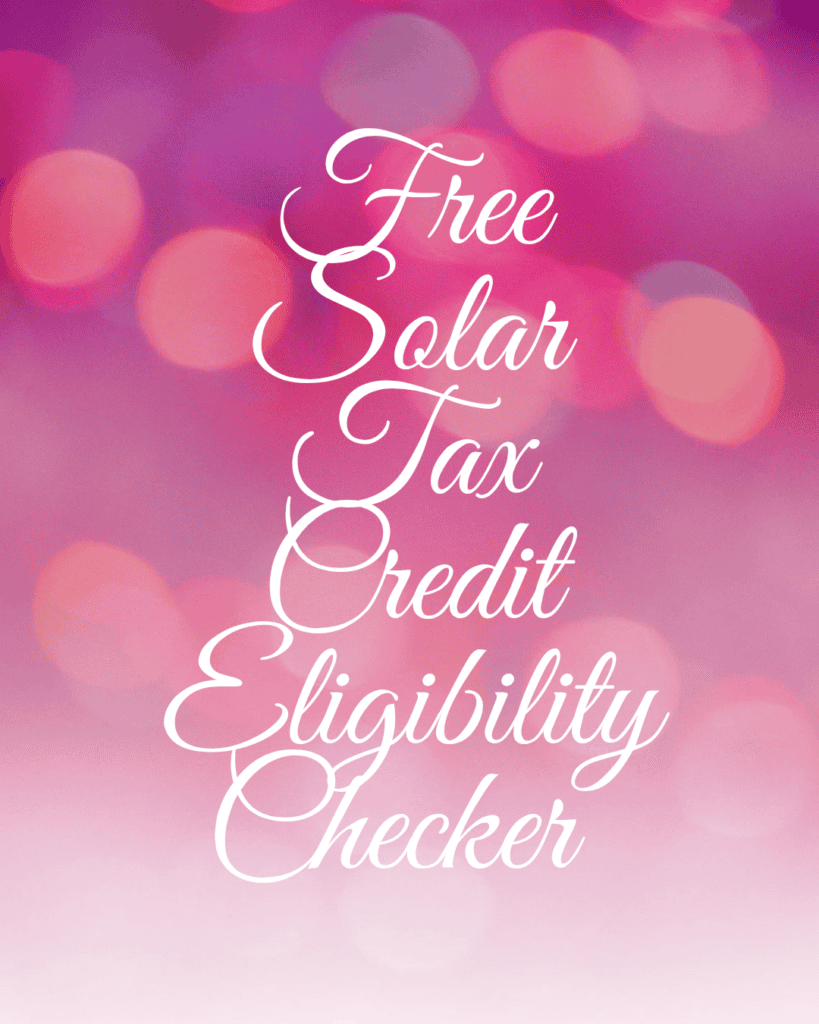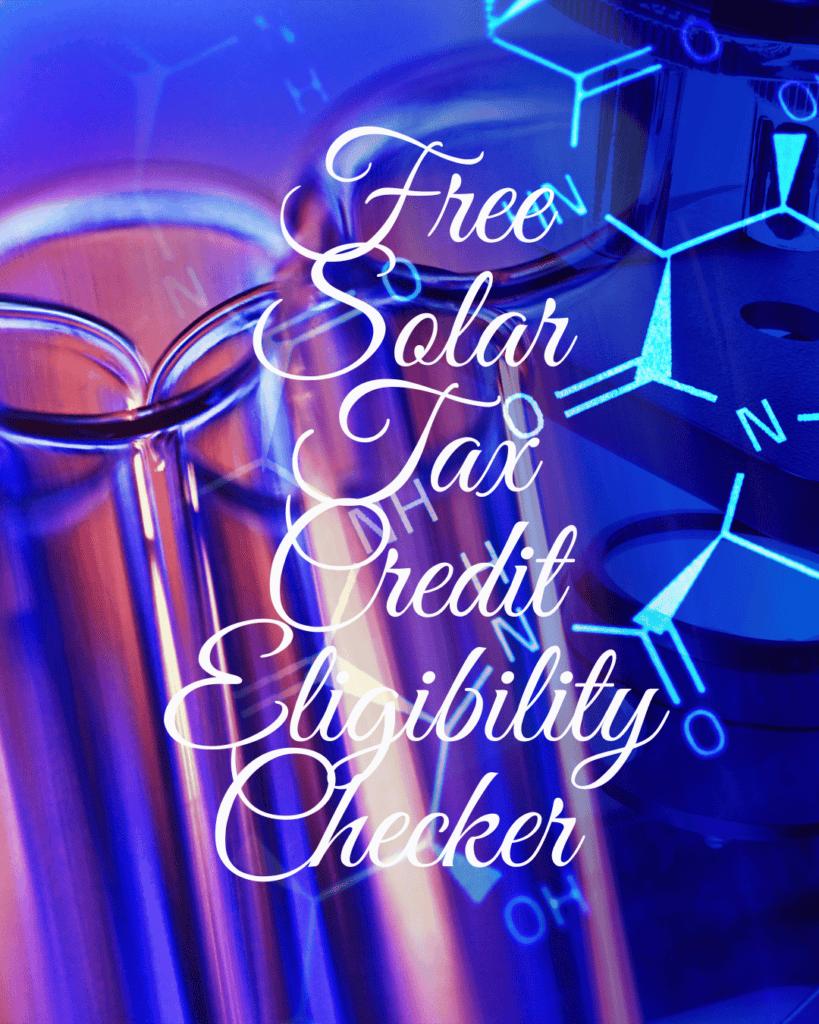Solar Tax Credit Eligibility Checker
Free Solar Tax Credit Eligibility Checker
The Residential Clean Energy Credit is an effective way for homeowners to reduce some of the expenses associated with installing rooftop solar systems. To claim it, they must own their systems and submit IRS Form 5695 along with their taxes.

Contrasting with deductions, which only reduce taxable income, tax credits offer dollar-for-dollar tax reduction benefits. Discover more about this incentive and its requirements here.
Eligibility
The Federal Residential Clean Energy Credit (RCEC) allows homeowners to claim up to 30% of the cost of solar energy systems as an income tax deduction. It applies both for newly constructed and existing homes; credits do not need to be repaid in full each year but any unused credit may be carried forward into future years. Calculation: Add your system costs together with total income taxable amounts for an estimate of your credit value.
Contrary to its counterpart, the Residential Clean Energy Credit (RCEC) can be claimed by homeowners of any income level who purchase and install solar equipment on either their primary or secondary residence. However, in order for the IRS to verify your expenses as being real and eligible for the credit, additional documentation such as receipts must be kept relating to costs related to your solar energy system as well as an itemized invoice from your contractor. Once all necessary receipts have been compiled complete IRS Form 5695 with your tax return for consideration.
To qualify for the Residential Clean Energy Credits (RCECs), your solar energy system must be owned and used as your primary or secondary residence. Rental properties or systems leased through power purchase agreements do not qualify; additionally, equipment must be installed directly onto your property and not used for business investments.
Before investing in solar, make sure that you owe enough taxes to qualify for the Residential Clean Energy Credit (RCEC). If unsure whether your home meets all requirements, consult with a certified tax preparer or visit your local solar energy company to evaluate whether claiming an RCEC incentive makes financial sense; just remember it expires by 2034 so plan now!
Costs
The Residential Clean Energy Credit (RCEC) is an invaluable incentive that makes switching to solar more cost-effective. Unlike rebates or deductions, which reduce taxes directly, this tax credit reduces them directly and cannot be claimed only on certain costs associated with installing solar power in your home.
Not only can consumers of solar energy take advantage of the ITC, but there are also federal and state incentives available for them as part of a solar installation project. Some incentives offer performance benefits while others aim to lower upfront costs of installation. Although rebates and incentives can help significantly bring down overall project costs, they should not be used to offset your federal tax credit costs.
Claim the ITC if you own your home, possess valid credit or bank accounts and earn taxable income. Furthermore, installing a solar energy system and using it to produce electricity for residential purposes qualifies you for this credit; any costs related to solar installation such as panels, inverters, installation costs as well as labor permits fees and sales tax payments qualify as expenses that qualify.

To claim an ITC, file Form 5695 along with your annual taxes. The value of the credit is calculated by multiplying qualified costs by 30% and using this value to calculate your tax liability on IRS Form 1040. Keeping a copy of all receipts can also help in case of audit by the IRS requesting proof that expenses listed were indeed spent.
RCECs are not intended for rental properties or houseboat or condominium purchases; they must only be claimed on primary residences owned outright or under lease agreement; second homes can claim this tax credit provided they serve as their principal home for most of the year.
Taxes
The federal tax credit for solar can provide homeowners with an invaluable incentive to install renewable energy systems. It discounts from the total cost and can be reimbursed through your tax liabilities for up to five years; available whether buying it outright or financing it; combined with utility rebates and state/local incentives (please be mindful that any state rebates may impact how your federal tax credits are calculated); available only when financing.
The Residential Clean Energy Credit (RCEC) offers a 30 percent tax credit on solar and renewable energy systems installed in either your primary or secondary residence. It covers the gross cost of your system, such as panels and equipment costs plus installation expenses such as labor contracts, permit fees, inspection costs, sales tax. To assist in filling out Form 5695 correctly for maximum savings from solar energy systems.
Typically, the Residential Clean Energy Credit (RCEC) applies to solar panel installations owned by homeowners who own them free and clear; it does not cover lease agreements or Power Purchase Agreements (PPA). Furthermore, commercial projects and solar water heating systems do not qualify. If unsure, an online tool like EnergySage Solar Tax Calculator may help determine eligibility.
Solar energy prices have seen significant decreases over the last decade, yet it remains an investment worth making. To encourage people to make the switch from fossil fuels, the government offers numerous attractive incentives – including tax credits which could save tens of thousands in savings while simultaneously lowering greenhouse gas emissions and slowing climate change.
The Solar Investment Tax Credit (ITC) provides a 30% rebate off your solar energy system costs by lowering your taxable income. You can claim it when filing your annual taxes with the IRS; working with an accountant may help prepare paperwork on your behalf, while you can claim it yourself using EnergySage or similar tools.
Requirements
The federal solar tax credit (ITC) is available to homeowners who install renewable energy solutions at either their primary or secondary residence in the US, acting as a key incentive to reduce carbon emissions and transition towards clean energy solutions. Saving homeowners thousands by taking advantage of this incentive can make the ITC even more valuable; particularly those with high electricity bills or large tax liabilities. Furthermore, unlike many renewable energy incentives which only last temporarily.

To qualify for this credit, both you and your solar energy system must be new. The credit applies to photovoltaic solar systems, battery storage and other renewable energy equipment like solar water heaters, geothermal pumps, fuel cells or wind turbines installed as part of a power purchase agreement or lease; only owners of their system are eligible to claim it.
To claim the Residential Clean Energy Credit, you must possess a valid Social Security Number and pay federal income taxes. Furthermore, you must owe enough tax this year to use up the entire credit amount; any excess can be carried over into next year. IRS Form 5695 can help you claim it or professional return preparers can file returns on your behalf.
To claim the RCEC, you will need proof of expenses such as invoices from contractors. To calculate your tax credit value, combine the costs of qualified solar energy systems and any eligible deductions/credits before multiplying that final sum by 30% to determine your tax credit value and add it to what is owed on your tax return. While you could do all the math yourself, working with a professional tax preparer familiar with renewable energy incentives might save you thousands!
